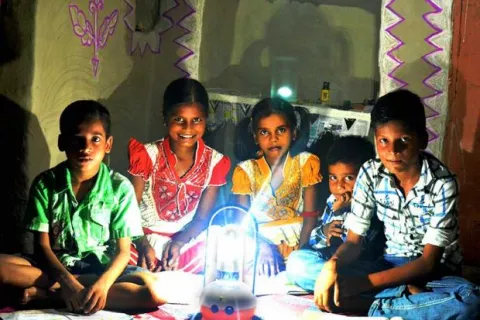
With the aim for last-mile connectivity to cover India with 24x7 electricity supply, what would be the best way to bring light to our dark hinterland? There happens to be micro-ray of hope and, is none other than distributed renewable energy (DRE).
Meanwhile, one may ask as to why putting up micro-grid projects in the hinterland or hamlets is a good business proposition? Because for a State electricity board to put up a grid extension network in such areas is much costlier as compared to setting up a micro-grid project.
The government spends around Rs 5-6 crore to set up a 1 km transmission network (considering land and end-to-end cost), whereas it takes just Rs 3 lakh to set up a 1 kW solar micro-grid which gives 24 hours supply to around 30 households. Normally the size of the micro-grid project differs from 120 watts to 10 kW for a 15-100 household village catering to household and village enterprise needs including water pumping etc.
Overall, experts estimate the market size of the DRE space to be at least Rs 933 crore by 2018, largely driven by B2B revenues. Not all B2B companies will expand to household DRE offerings, but experts have seen some B2B enterprises begin to do so.
Off-grid DRE businesses serve close to 100,000 households today, and this number is set to grow rapidly at 60-70 per cent annually to around 900,000 by 2018. While the household market will generate annual revenues of Rs 280 crore by 2018, the commercial rural infrastructure is growing and presents a huge B2B opportunity to ensure stable revenues from anchor clients alongside households.
Companies looking to serve businesses can tap into a range of enterprises such as rural mobile towers, ATMs and petrol pumps, and secure large scale contracts to drive the expansion. Potential revenues from serving rural mobile towers alone could grow to at least Rs 540 crore by 2018. And in light of a government of India mandate requiring 50 per cent of all rural cell towers to shift to renewable energy, this number could be significantly higher.
Conservative estimates suggest that the DRE sector will grow at a cumulative average rate of 50-60 per cent over the next five years (2015-19). At this rate, the installed mini-grid capacity would reach 90 MW by 2019, requiring an investment of around Rs 1,555 crore in plant assets between 2015-19.
Projected at the same rate, DRE installed capacity would reach 330 MW by 2022. To put this in perspective, DRE instalments would account for 16 per cent of the Jawaharlal Nehru National Solar Mission (JNNSM) target of 2,000 MW for off-grid solar capacity by 2022. The JNNSM target includes consumer products such as solar home systems, captive generation as well as mini-grid installations. Reaching this capacity would require investments worth around Rs 6,200 crore in plant assets, between 2015 and 2022.
Now let’s touch upon the possible geographical business opportunities for DREs in India. A number of DRE developers that we spoke to suggested that Uttar Pradesh, Bihar, Odisha, West Bengal and Madhya Pradesh hold the prime geographical business presence as more than half of the total underserved rural population lives in these five States.
At the end, with 50% of the
rural population underserved due to them being cut off from grid network, for micro-grid entrepreneurs, it works out to be the opportunity that cannot be overlooked.



